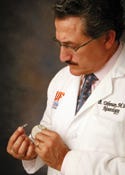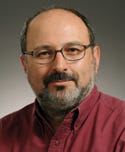Variety Could Be the Key to Neurostimulation
April 1, 2008
R&D DIGEST
|
Researcher Basim Uthman says that pattern recognition could be keeping the brain from responding to neurostimulation. |
Researchers from the University of Florida (UF; Gainesville) are hoping that variety is the component that keeps neurostimulation alive. They have developed a technology called variational neurostimulation, which may prevent the body from adapting to and resisting stimulation therapy.
“We think that the brain and the seizure focus are smart and find ways around stimulation,” says Basim Uthman, MD, associate professor of neurology at UF. “Although it may sound counterintuitive, the [brain's] normal activity is chaotic and random. Seizure activity is more of a synchronous activity—it's very organized.”
The researchers compare the body's resistance to stimulation with patients who take antibiotics in the hospital. “When you use certain antibiotics, after a while, they're not effective,” says Uthman. “The bacteria change and because of the environment, they make adjustments so that they won't be killed by the
antibiotics.”
In order to fool the brain, the researchers have designed a scheme in which no particular stimulus is the same as the previous one. By altering the electrical stimulation, the brain doesn't have a chance to learn the pattern.
“We want to program [the scheme] in a variational way that won't allow the central nervous system and its disorders to habituate to the therapeutic effect of the stimulation,” Uthman says.
Uthman and Panos Pardalos, PhD, are working on how to deliver combinations of different stimulation parameters at various frequencies. Pardalos is a professor of industrial and systems engineering at the university.
The technology also uses data mining and analysis to find certain patterns that could help identify disorders in the brain.
|
Panos Pardalos, PhD, works with Uthman to define the stimulation parameters and develop combinations at various frequencies. |
Uthman hopes that in addition to regulating seizure activities, the technology can be used to treat disorders such as Parkinson's and Alzheimer's diseases. It is currently designed for integration into existing stimulation devices, and it can be used in both the central and peripheral nervous systems.
Uthman is open to working with people who want to apply the technology to different conditions. At UF, the researchers are using the technology to address movement disorders.
“A lot [of disorders] have to do with rhythmic episode phenomenon,” says Uthman. “Maybe with time, this technology may work with deep brain stimulation and not just with vagus nerve stimulation.” It might have use in spinal chord stimulation to treat pain disorders as well.
Uthman says that the technology's program is complex. Manufacturers may need to revise a neurostimulation device so that it has the capacity to run the program. However, he emphasizes that the technology is in its early developmental stages, and the team needs to prove the concept.
The UF researchers plan to introduce the program to rats that have stopped responding to traditional stimulation. If the researchers receive approval to conduct human studies, they hope to find out if the technique works better than current methods of neurostimulation.
“Although vagus nerve stimulation has been used for a long time, nobody knows why it works the way it works. Only lately have we tried to see what we changed in the brain.”
UF's Office of Technology Licensing is currently looking for companies interested in the patent-pending technology.
Copyright ©2008 Medical Device & Diagnostic Industry
About the Author(s)
You May Also Like



.png?width=300&auto=webp&quality=80&disable=upscale)
